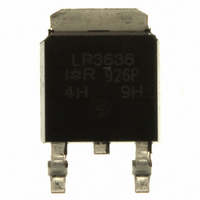IRLR3636TRPBF International Rectifier, IRLR3636TRPBF Datasheet - Page 5

IRLR3636TRPBF
Manufacturer Part Number
IRLR3636TRPBF
Description
MOSFET N-CH 60V 50A DPAK
Manufacturer
International Rectifier
Series
HEXFET®r
Datasheet
1.IRLR3636TRPBF.pdf
(10 pages)
Specifications of IRLR3636TRPBF
Fet Type
MOSFET N-Channel, Metal Oxide
Fet Feature
Logic Level Gate
Rds On (max) @ Id, Vgs
6.8 mohm @ 50A, 10V
Drain To Source Voltage (vdss)
60V
Current - Continuous Drain (id) @ 25° C
50A
Vgs(th) (max) @ Id
2.5V @ 100µA
Gate Charge (qg) @ Vgs
49nC @ 4.5V
Input Capacitance (ciss) @ Vds
3779pF @ 50V
Power - Max
143W
Mounting Type
Surface Mount
Package / Case
DPak, TO-252 (2 leads+tab), SC-63
Transistor Polarity
N Channel
Continuous Drain Current Id
99A
Drain Source Voltage Vds
60V
On Resistance Rds(on)
5.4mohm
Rds(on) Test Voltage Vgs
10V
Threshold Voltage Vgs Typ
2.5V
Rohs Compliant
Yes
Lead Free Status / RoHS Status
Lead free / RoHS Compliant
Other names
IRLR3636TRPBFTR
Available stocks
Company
Part Number
Manufacturer
Quantity
Price
Part Number:
IRLR3636TRPBF
Manufacturer:
IR
Quantity:
20 000
www.irf.com
Fig 15. Maximum Avalanche Energy vs. Temperature
200
150
100
50
0
25
0.001
1000
0.01
100
Starting T J , Junction Temperature (°C)
0.1
0.1
10
10
1.0E-06
1
1E-006
1
50
Fig 13. Maximum Effective Transient Thermal Impedance, Junction-to-Case
Allowed avalanche Current vs avalanche
pulsewidth, tav, assuming ∆Τ j = 25°C and
Tstart = 150°C.
TOP
BOTTOM 1.0% Duty Cycle
I D = 50A
75
Duty Cycle = Single Pulse
D = 0.50
100
0.10
0.20
0.05
0.02
0.01
0.10
Single Pulse
0.05
0.01
SINGLE PULSE
( THERMAL RESPONSE )
1.0E-05
1E-005
125
Fig 14. Typical Avalanche Current vs.Pulsewidth
150
175
t 1 , Rectangular Pulse Duration (sec)
1.0E-04
0.0001
Notes on Repetitive Avalanche Curves , Figures 14, 15:
(For further info, see AN-1005 at www.irf.com)
1. Avalanche failures assumption:
2. Safe operation in Avalanche is allowed as long asT
3. Equation below based on circuit and waveforms shown in Figures 16a, 16b.
4. P
5. BV = Rated breakdown voltage (1.3 factor accounts for voltage increase
6. I
7. ∆T
τ
J
τ
Purely a thermal phenomenon and failure occurs at a temperature far in
excess of T
during avalanche).
25°C in Figure 14, 15).
t
D = Duty cycle in avalanche = t
Z
J
tav (sec)
τ
av
av =
1
Ci= τi/Ri
thJC
D (ave)
τ
1
Ci
= Allowable avalanche current.
=
Average time in avalanche.
(D, t
Allowable rise in junction temperature, not to exceed T
i/Ri
R
= Average power dissipation per single avalanche pulse.
1
av
R
1
) = Transient thermal resistance, see Figures 13)
Allowed avalanche Current vs avalanche
pulsewidth, tav, assuming ∆Tj = 150°C and
Tstart =25°C (Single Pulse)
1.0E-03
jmax
0.001
τ
2
τ
R
. This is validated for every part type.
2
2
R
2
P
D (ave)
R
τ
3
3
R
τ
3
3
= 1/2 ( 1.3·BV·I
I
E
av
Notes:
1. Duty Factor D = t1/t2
2. Peak Tj = P dm x Zthjc + Tc
AS (AR)
τ
= 2DT/ [1.3·BV·Z
R
4
τ
4
R
4
av
4
1.0E-02
·f
τ
C
= P
τ
0.01
Ri (°C/W)
0.02028
0.29406
0.49179
0.24336
D (ave)
av
IRLR/U3636PbF
) = DT/ Z
·t
th
av
]
0.001393
0.00725
0.000011
0.000158
τi (sec)
jmax
thJC
jmax
is not exceeded.
1.0E-01
(assumed as
0.1
5











